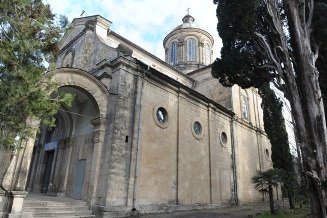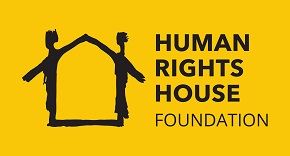Natia Gogolashvili
Nowadays, there are five historical churches in Georgia which the Catholic Church claims as theirs though all of them now belong to the Georgian Orthodox Church. The disputed churches are located in Kutaisi, Gori, Batumi, Ivlita (Akhaltsikhe municipality) and Ude (Adigeni municipality).
Construction of the Kutaisi Annunciation Church was finished in 1862. Now it belongs to the Orthodox Church. It has status of culture heritage. Orthodox service is conducted there though majority of Catholic ornaments are preserved in the interior.
Local Orthodox people tell different stories: “Catholics got hold of the church in 1940s and remodeled it. We got it back about 30 years ago and it belongs to us since 1980s. We have not changed anything in it yet. The Catholics claimed the church, but they lost trial at the court,” Ms. Elene, who has been selling candles in the former confession compartment of the Catholic Church, for 2-3 months. Ms. Elene showed us the room for baptizing and blocked door to prove that the church initially was Orthodox and then it was changed by the Catholics.
“At the first sight it is not easy to detect changes in the Kutaisi Annunciation Church. The Orthodox parish got rid of the old organ in the beginning of 1990s. As for the confession compartments, they are now used for the sale of candles. On the façade we now see an inscription stating that in the past there was Orthodox Church here, which was destroyed by Catholics and new one was constructed instead. It is historical fabrication, with which they are trying to justify seizure of property from the Catholics,” head of the chancellery at the South Caucasus Latin-Catholics Apostolic Administration Padre Akaki Tchelidze.
”There were several catholic churches in Kutaisi. In XVII century one of them was wooden building and King Solomon assigned it to the missionaries. The church needed reconstruction; later a stone church was constructed next to it. The building started in 1862 and lasted too long. For a while all Catholic clergymen were expelled from the Russian Empire and the construction of this church finished in 1862. Since 1939 Catholic service has never been conducted there. It is enough for us if the Orthodox Church will admit that it was our church and if they need they can use it for as long time as they need. Simply, they should at least assign one church to us, for example Kutaisi Church. In fact, the Orthodox Church does not have any document to prove that it was their property. We met them many times before appealing to the court but all was in vain,” deacon of the Catholic Church Kote Otskheli said.
“The church was constructed with orthodox architecture; both interior and exterior prove it. Catholics abolished northern and southern gates of the church and set up statues that you see now: statues of the Christ and Holly Mother. They are culture monuments and we do not touch them,” said representative of the Orthodox Church Archpriest Besarion Khvistani.
The Orthodox version of the church history is the following: “In the ancient times Georgian royal families lived here during summer times; there was royal palace here. Consequently, the royal family had their church and chapel. There was a wooden church here and it was burnt in obscure situation. During the King Aleksandre the church temporarily sheltered a catholic missionaries, that was huge mistake of the King because according to the kanonikos he was not owner of the church and could not assign it to the followers of other religion. As you know there is controversy between Catholic and Orthodox Churches and according to the kanonikos we cannot assign our churches and monasteries to them. Afterwards, the church was burnt in obscure situation and during Russian Governor Vorontsov this church was constructed,” Archpriest Besarion Khvistani said.
Deacon Kote Otskheli said until mentality is changed in Georgia, it is impossible to get the church back. He said Orthodox parish cannot change their attitude towards religious minorities for years. “In 1988-1989, at the end of Soviet Union, so called “law on twenties” was adopted and people started to open churches; according to this law it was enough to collect 20 signatures to renew services in the churches. We collected 36 signatures but Catholic parish was told the collected signatures were not enough; thus they dragged out the process. Meanwhile we collected up to 200 signatures. In parallel to that, the Orthodox Church also started activities. We sent a letter to Moscow but word “catholic” was removed from the Russian translation of the letter and in Moscow they accepted the letter as if Orthodox parish was asking for the church,” Kote Otskheli said.
As it was noted, in 1990s, the court assigned the disputed church to the Orthodox parish. Kote Otskheli said it was judiciary fabrication because the court did not consider any evidence provided by the Catholic side. “They disseminate wrong information because we sued the President at the court and not the Orthodox Church. President Eduard Shevardnadze illegally assigned the church to the Orthodox parish. We have documents to prove it but they neglected our evidence. The plaintiff side did not have any proofs at all; they still do not have anything to prove. It is noteworthy that before we appealed to the court, we tried to contact the Orthodox clergymen. We asked them to study the issue but in vain. We could even appeal the Strasbourg court but that time ambassador of the Vatican suggested us not to aggravate the situation.”
“Holy justice was restored and we got the church back. The court also acknowledged that historically royal orthodox church was functioning in the territory and consequently it was returned to us,” Archpriest Besarion Khvistani said.
To summarize, the head of the South Caucasus Latin-Catholics Apostolic Administration Padre Akaki Tchelidze said the main problem of the catholic community is issue of seized properties. Besides that, as Kote Otskheli said, the problem is that Civil Registration Agency does not register chapels of Catholic community as churches. “For example, we do not have electricity supply meter in Akhalsheni because we cannot register the church. We have problems in Rustavi too: the territory was allocated, we have project but cannot start construction. Nobody knows why we cannot get permission. It is fact that similar issues are blocked in higher instances. Nowadays, it is incredible to build catholic churches in the town,” Kote Otskheli said.
At this stage, as reported by the Orthodox parish, reconstruction of the church is planned in Kutaisi. “We also request to reconstruct it. After the church was roofed, it was painted in different colors. There was culture center here and apparently it was painted in different colors because of it. So, we need that walls were cleaned. The church is built on colonies. When everything is cleaned and we see the stones, everybody will see old version of the church. We also request to roof the church. We expect this issue will be resolved in spring. Now we need to roof the church and conduct interior works to restore old image of the temple,” Father Besarion Khvistani said.
It is fact that both Orthodox and Catholic parties are absolutely convinced that the church belongs to them. At the same time, it is fact that they still continue argument about it. We still hear questions which have different answers. So, it is important that the state impartially resolved this dispute.
“It is important that the church has status of culture heritage. Consequently, it is inadmissible to selfishly remodel it for the purpose of restoration. The Agency for the Protection of Culture Heritage identifies necessity of restoration, and approves the restoration plan; it also supervises reconstruction process. Lately, cases of willful reconstruction of culture heritage monuments has increased that is often done by the Orthodox clergymen,” executive director of Human Rights Center Aleko Tskitishvili said. Human Rights Center calls on the Agency for the Protection of Culture Heritage to get interested in the issue of Kutaisi Annunciation Church and combat all attempts of willful transformation or damage of culture heritages.
Photo-reportage by Goga Chanadiri
The article was prepared in the frame of the project implemented with financial support of the Government of Canada. This article does not necessarily reflect the views of the donor.
Human Rights Center bears sole responsibility for the content of the article.
News
December 13, 2023
Ethnic minorities outside the peace dialogue
November 6, 2023
‘Peace’ agenda of political parties
Popular
Articles
February 13, 2024




